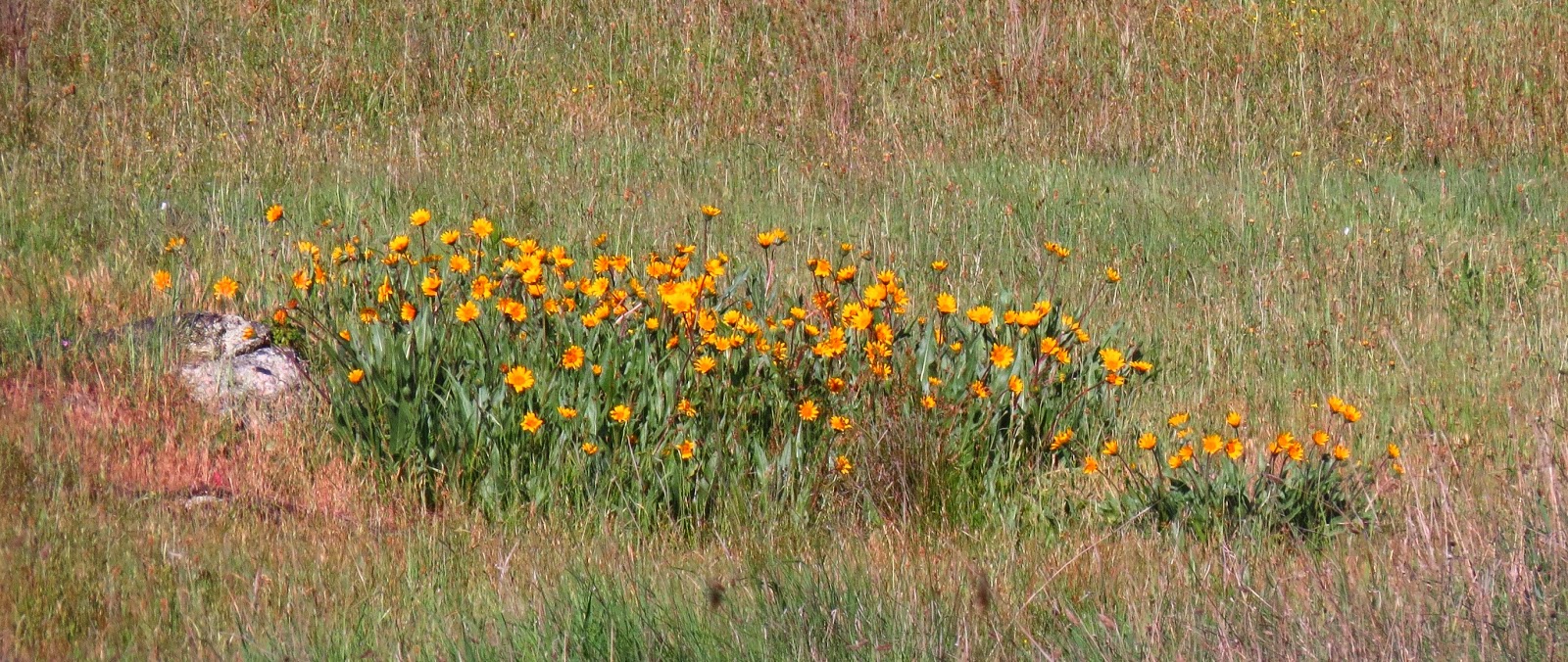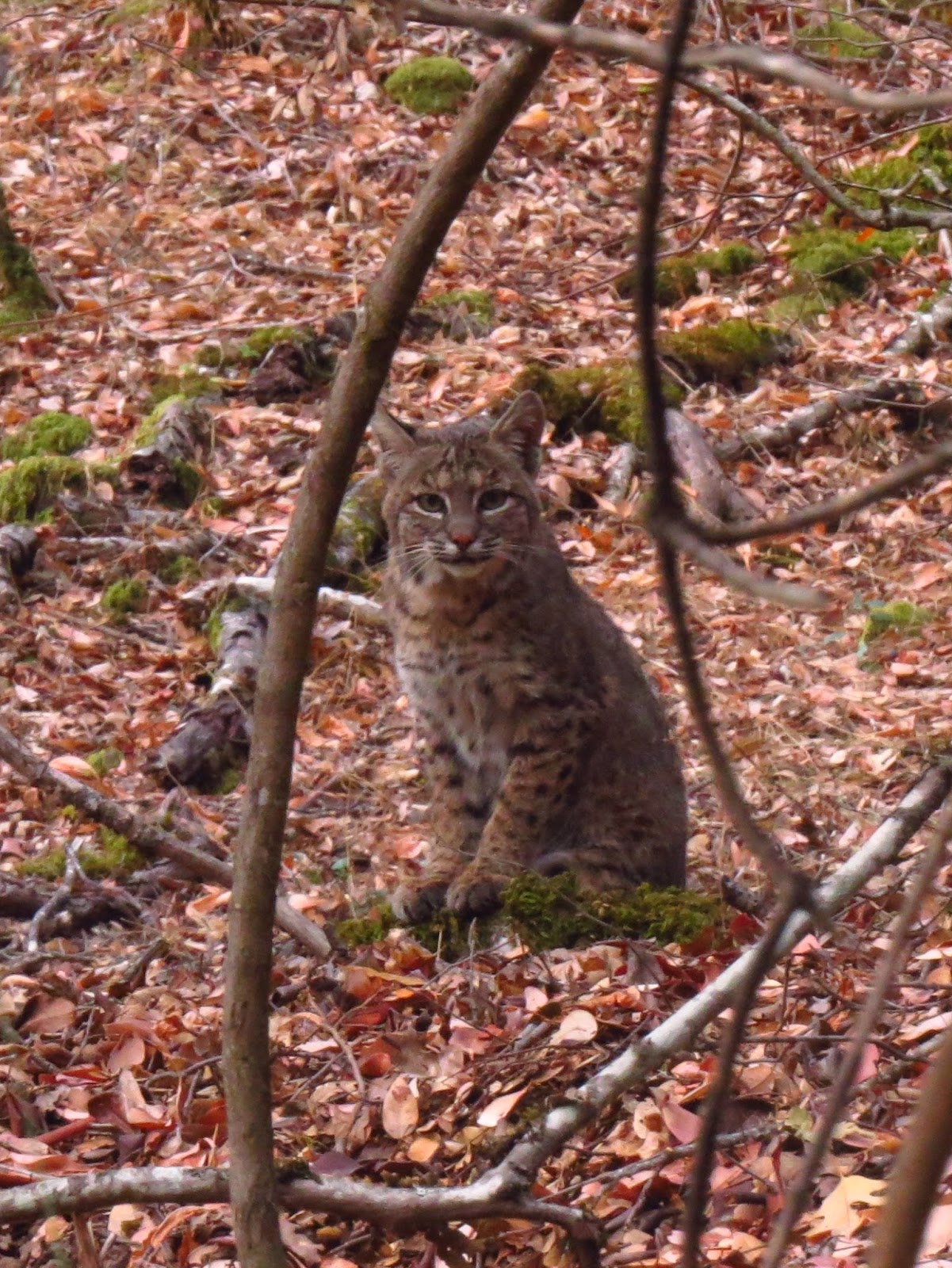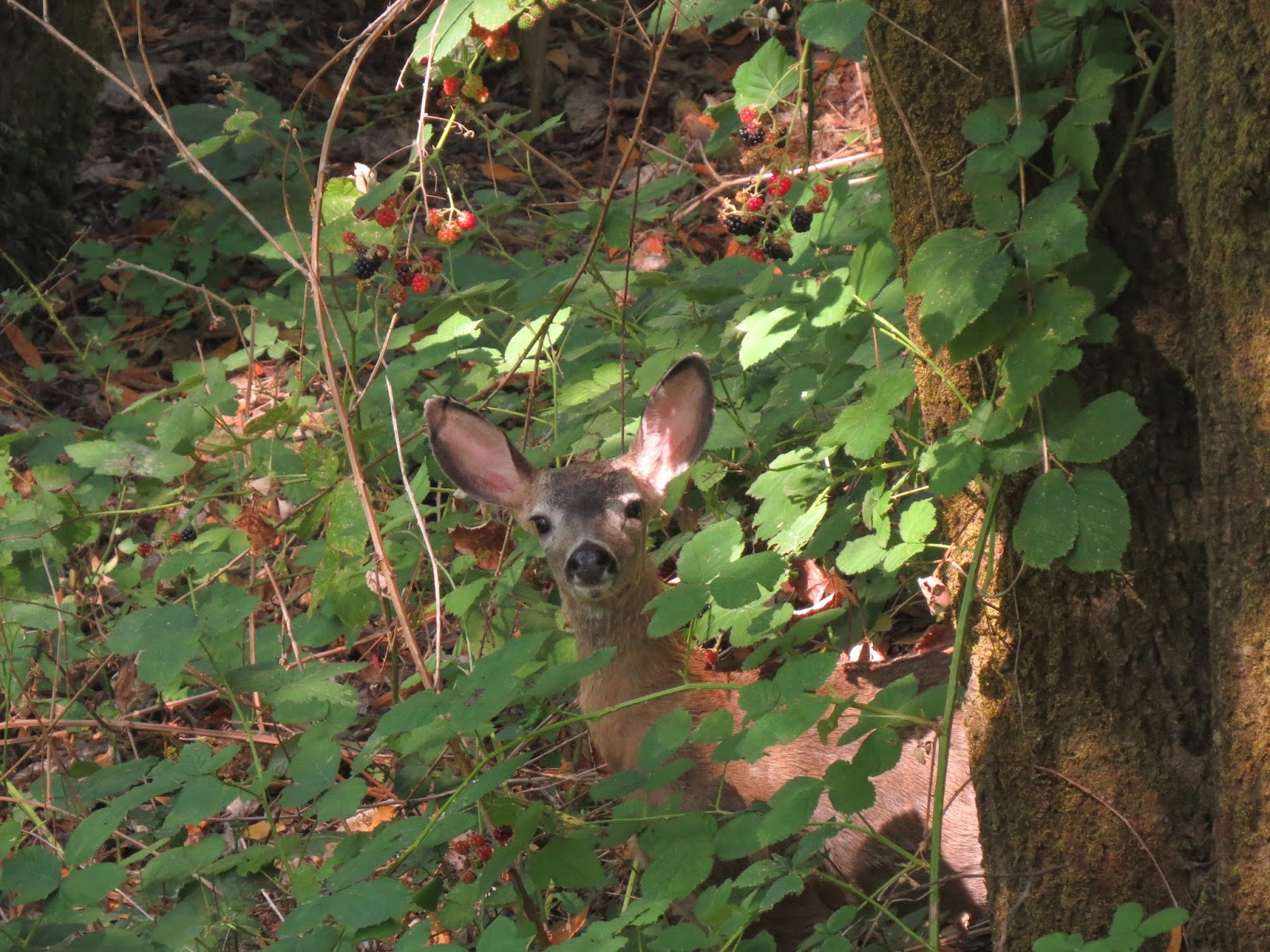From the deep wilds of California's parks to the glimpse of a bluebird over a backyard fence, from the geologic bones of the mountains to the tiny spring wildflower in an empty lot -- California's natural worlds are everywhere, and endlessly fascinating.
Saturday, May 31, 2014
Male Oriole in an oak tree
These stunning orange orioles come to visit every year in the spring, and set up their nests around lakes and ponds to raise their young. They weave intricate hanging nests - using lichen and moss if they must, but they far prefer fishing line and bits of old tarps!
Friday, May 30, 2014
Thursday, May 29, 2014
Wednesday, May 28, 2014
Blue sky, blue lupines
Tuesday, May 27, 2014
Mule's Ears in flower
Monday, May 26, 2014
Black Phoebe Nest
I found this Black Phoebe nesting under some overhanging grasses on a stream bank. They like to nest on cliffs, walls, and ledges - you'll often find then under the eaves of your house.
Sunday, May 25, 2014
Duckling time
Spring is when all of the baby birds begin to appear -- such as these three little mallard ducklings following mama around on Lake Mendocino.
Saturday, May 24, 2014
California Poppies
These beautiful orange wildflowers are California's official state wildflower, and it's easy to see why. When they bloom, they can make fields seem to glower with orange light.
Friday, May 23, 2014
Water Strider Shadows
Water striders appear in streams and puddles in late spring, and can be found throughout the summer. They stand atop the water, using surface tension to keep themselves afloat. An interesting side effect of the way their feet dent the surface of the water is the incredible shadows they create.
Thursday, May 22, 2014
Wednesday, May 21, 2014
Blue Flowering Ceanothus
| Ceanothus |
The bushes make great habitat for nesting birds, particularly towhees and jays, and the flowers are always alive with buzzing bees.
Tuesday, May 20, 2014
Blue-eyed grass
You won't notice these wildflowers until they open their distinctive blue and yellow blossoms. As the name hints, the leaves look a lot like grass. They're everywhere in grassy meadows and roadsides once spring hits!
Monday, May 19, 2014
Elderflowers
I always get excited when the elderflowers bloom. Tall bushes with pancake-shaped clusters of small yellow-white blossoms suddenly become apparent in all the roadsides and fields, and it's time to go collecting. The leaves and stems are poisonous, but the flowers themselves are edible and quite delicious.
I add them to pancakes or breads, and dry them for use in tea later in the year. [The ripe berries are also quite nice as a tea!]
Sunday, May 18, 2014
Silene Hookeri flowers
I was pleased to find these small pink blossoms peeping out from the grass at the edge of a train on South Cow Mountain. They're native to California and Oregon, and not terribly common, so it's always a treat to spot one!
Saturday, May 17, 2014
Pink Rhododendrons
When you first see the wild rhododendrons on the Mendocino Coast, it's hard to believe that they're actually wildflowers, not something that escaped from someone's garden. The bushes are covered with huge masses of pink blossoms everywhere you look.
Friday, May 16, 2014
Wild Blue Lupines
Masses of blue and white wild lupines growing near Deerwood at the south eastern end of Lake Mendocino.
Thursday, May 15, 2014
Western Skunk Cabbage in bloom
Skunk cabbage is named for the distinctive smell it produces when it blooms, which attracts its pollinating insects. It grows in damp areas along streams, usually near to the coast. This photo was taken just north of Fort Bragg, California.
The leaves can grow to enormous sizes. I've seen them get 4 or 5 feet long and several feet across.
Wednesday, May 14, 2014
Green aphid
A little green aphid walks across the dry desert of a parking lot. These small creatures are commonly known as garden pests, for they feed on plant juices.
Ants regard them as we do cows, and frequently form aphid herds which they tend and guard, in return for collecting a sweet sugary secretion that the aphids produce for them. If they're eating your garden, don't blame the aphids, blame their 'owners'.
Tuesday, May 13, 2014
Blue Damselfly
Damselflies are a cousin to the better-known dragonfly, and live in similar habitats. You'll find them around the edges of ponds and streams, where they skim over the water hunting small insects. I found this one just up the hill from Mill Creek Pond near Ukiah California.
Monday, May 12, 2014
Treefrog
Treefrogs are a small frog, around the size of your thumb. They come in all colors of green and brown and even camo-patterned, with bright golden eyes. You can hear them singing in wet areas and the edges of ponds throughout the spring.
This one was sitting in a puddle near the Little River Airport in Mendocino County.
Sunday, May 11, 2014
Buckeye Blossoms
When the buckeyes begin to bloom I know summer is just around the corner. They put out huge spikes of white or pinkish fragrant blossoms that perfume the air all around. It often grows on steep, rocky hillsides, and has adapted to its environment by going dormant and losing its leaves in mid summer as water grows scarce.
It tends to be a favored nesting site for bluebirds, which often raise their young in hollows in the trunks.
Saturday, May 10, 2014
Bobcats on the prowl
I saw the lovely lady above on a drive out to Cow Mountain near Ukiah. She had been feasting on the carcass of a roadkilled deer, and dashed a little ways into the woods when I drove up. After taking several photos of her, I began to wonder why she hadn't run off further.
That's when I looked out the other window, and saw her half-grown kitten waiting patiently in the woods on the other side of the road! I snapped a couple photos of it as well, and then drove on so as to allow them their reunion.
Friday, May 9, 2014
Downingia on South Cow Mountain
Downingia is an annual plant that likes to grow in vernal pools, coming into bloom as the water dries up. Sometimes they make incredible mats of blue-and-yellow flowers. These ones were found at a pool on South Cow Mountain.
Thursday, May 8, 2014
Spring buttercups near Willits
Sometimes in the spring, the fields transform to masses of brilliant gold due to all the buttercups in bloom. This usually happens on pastureland, because buttercups are poisonous and the animals won't eat them - so as the competition gets devoured, the buttercups take over.
Wednesday, May 7, 2014
Wild ceanothus
Wild ceanothus [sometimes called California Lilac] blooming on Cow Mountain. It comes in white, bright blue, sky blue, and even sometimes pale pink. When it's all in bloom, the hillsides look like some fantasy-land fairy's garden.
Tuesday, May 6, 2014
Monday, May 5, 2014
Anna's Hummingbird
This little bird is about the size of your thumb. The males have bright red throats, so the one above is either a female or a juvenile. It seemed quite happy to sit and prose for the camera for quite a long time.
Sunday, May 4, 2014
Western Fence Lizard
I was taking a photo of some wildflowers when I noticed this Western Fence Lizard watching me quite calmly from beneath a nearby bush. They're often known as bluebellies for their brilliantly blue undersides, and they're the most common lizard to be found in this area.
Saturday, May 3, 2014
Ground squirrel sunning itself
This plump ground squirrel was enjoying a few moments of sun early one morning. Its burrow is just outside the photograph, and when it decided it was tired of having a camera pointed at it, it scampered away down its hole.
Friday, May 2, 2014
Jackrabbit grooming near Lake Mendocino
Thursday, May 1, 2014
Fawn hiding in the blackberries
This fawn was hoping that if it only held very very still, I wouldn't be able to see it. And it nearly worked - the ears kind of gave the game away however!
Subscribe to:
Comments (Atom)



























